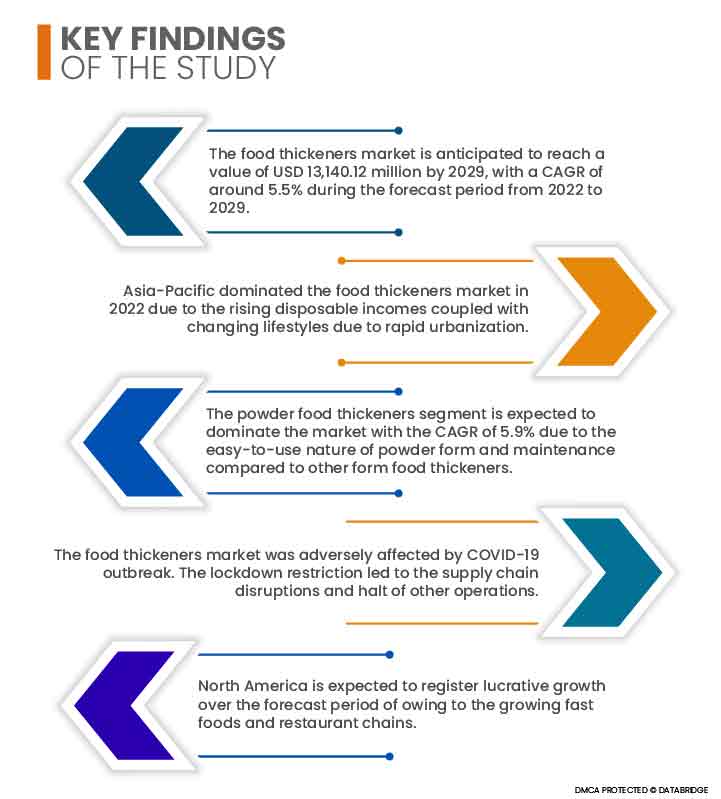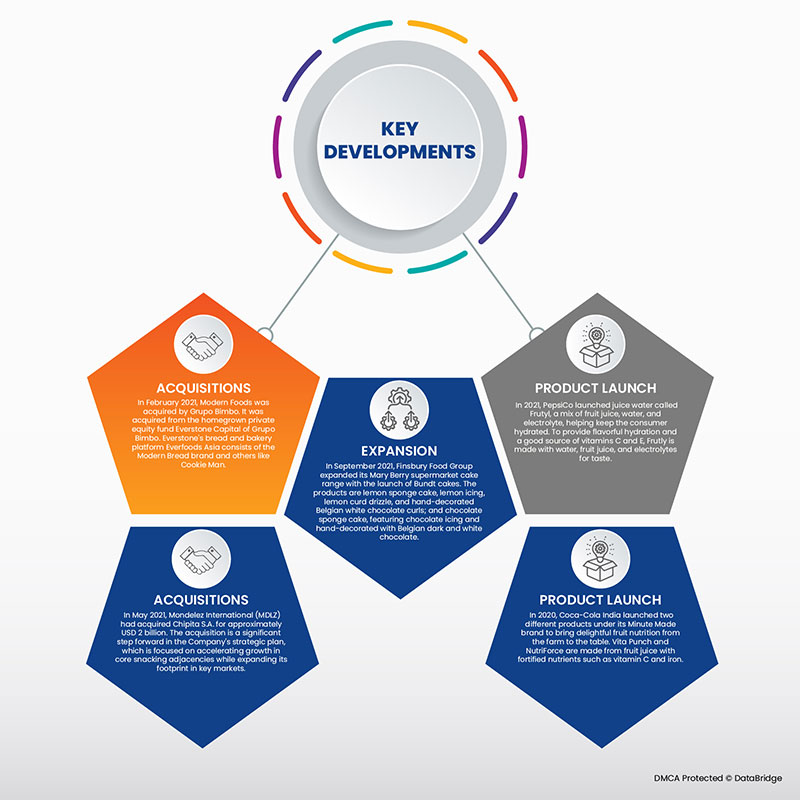오렌지, 사과, 망고, 혼합 과일 등 다양한 과일 주스는 건강에 다양한 효능이 있어 수요가 증가하고 있습니다. 과일 주스 수요 증가에 따라 식품 증점제 수요도 급증할 것으로 예상되며, 이는 시장 성장으로 이어질 것입니다. 더욱이 제조업체들은 다양한 맛을 선보이고 무방부제, 무설탕 과일 주스를 생산하여 소비자층을 확대하고 있으며, 이는 전 세계적으로 과일 주스에 대한 수요를 증가시키고 있습니다. 따라서 세계 식품 증점제 시장은 예측 기간 동안 빠르게 성장할 것으로 예상됩니다.
전체 보고서는 https://www.databridgemarketresearch.com/reports/global-food-thickeners-market 에서 확인하세요.
데이터 브리지 마켓 리서치(Data Bridge Market Research) 는 식품 증점제 시장이 2021년부터 2029년까지 연평균 성장률(CAGR) 5.5%로 성장하여 2029년에는 131억 4,012만 달러(USD)에 이를 것으로 분석했습니다. 1인당 소득은 식음료의 건강 및 웰빙 제품 지출 증가에 직접적인 영향을 미칩니다. 이는 다시 식품 증점제 수요를 증가시킵니다. 따라서 전 세계 1인당 소득 증가는 글로벌 식품 증점제 시장 성장의 주요 요인이 될 것으로 예상됩니다.

식품 응용 분야에서 활용도 증가로 시장 성장률이 촉진될 것으로 예상
식품 증점제는 기본적으로 식품 및 음료의 질감 구조를 변형하고 점도를 높이는 데 사용되는 식품 개질제입니다. 식품 및 음료가 제품에 통합되면 식품의 수분 함량을 흡수하는 데 도움이 됩니다. 이러한 제품은 주로 제품의 점도를 조절하여 일관된 구조를 만드는 데 사용됩니다. 시장에서 가장 널리 사용되는 식품 증점제는 전분이며, 그 다음으로 하이드로콜로이드와 단백질입니다. 식품 증점제는 제빵류, 제과류, 소스, 드레싱, 마리네이드, 그레이비, 음료, 유제품, 냉동 디저트, 편의식품 및 가공식품과 같은 식품 분야에 사용됩니다. 따라서 식품 및 음료 분야에서 식품 증점제의 높은 활용도는 시장 성장을 촉진할 것으로 예상됩니다.
보고서 범위 및 시장 세분화
보고서 메트릭
|
세부
|
예측 기간
|
2022년부터 2029년까지
|
기준 연도
|
2021
|
역사적인 해
|
2020 (2014~2019년으로 맞춤 설정 가능)
|
양적 단위
|
매출(백만 달러), 볼륨(단위), 가격(달러)
|
다루는 세그먼트
|
유형별(하이드로콜로이드, 단백질, 전분, 펙틴 및 기타), 형태별(분말, 과립, 젤, 기타), 특성별(비GMO, GMO), 출처별(식물, 동물, 해양, 미생물), 응용 분야별(식품, 음료)
|
포함 국가
|
미국, 북미의 캐나다 및 멕시코, 독일, 프랑스, 영국, 네덜란드, 스위스, 벨기에, 러시아, 이탈리아, 스페인, 터키, 유럽의 기타 유럽 국가, 중국, 일본, 인도, 한국, 싱가포르, 말레이시아, 호주, 태국, 인도네시아, 필리핀, 아시아 태평양(APAC)의 기타 아시아 태평양(APAC), 사우디아라비아, UAE, 남아프리카 공화국, 이집트, 이스라엘, 중동 및 아프리카(MEA)의 일부인 기타 중동 및 아프리카(MEA), 남미의 일부인 기타 남미 국가.
|
시장 참여자 포함
|
Ingredion(미국), Cargill, Incorporated(미국), CP Kelco US, Inc.(미국), Tate & Lyle PLC(영국), DuPont(미국), J&K Ingredients, Inc.(미국), Fiberstar(미국), Sunbloom Proteins GmbH(독일), Fismer Lecithin(독일), All American Foods(미국), Bob's Red Mill Natural Foods(미국), Cargill Incorporated(미국), Puratos(미국), Arla Foods amba(덴마크), ADM(미국), Glanbia Plc(아일랜드), Kerry Group(아일랜드), Florida Food Products(미국) 및 Corbion(네덜란드), Emsland Group(독일), Ashland(미국), ADM(미국), Jungbunzlauer Suisse AG(미국) 및 Solvay(벨기에).
|
보고서에서 다루는 데이터 포인트
|
Data Bridge Market Research 팀이 큐레이팅한 시장 보고서에는 시장 가치, 성장률, 시장 부문, 지리적 적용 범위, 시장 참여자, 시장 시나리오와 같은 시장 통찰력 외에도 심층적인 전문가 분석, 수입/수출 분석, 가격 분석, 생산 소비 분석, 특허 분석 및 소비자 행동이 포함되어 있습니다.
|
세그먼트 분석:
식품 증점제 시장은 제품 유형, 상처 유형, 상처 등급, 최종 사용자 및 유통 채널을 기준으로 세분화됩니다.
- 글로벌 식품 증점제 시장은 종류별로 단백질, 전분, 하이드로콜로이드, 펙틴 등으로 구분됩니다. 2022년에는 하이드로콜로이드 식품 증점제 부문이 2022년부터 2029년까지 연평균 성장률 5.0%로 시장을 주도할 것으로 예상됩니다. 이 부문의 높은 성장은 잼, 젤리, 마멀레이드, 츄잉껌, 저당/저칼로리 젤 등 제과류에서의 사용 증가에 기인합니다.
- 전 세계 식품 증점제 시장은 형태에 따라 겔, 분말, 과립 등으로 구분됩니다. 2022년에는 분말 식품 증점제 부문이 2022년부터 2029년까지 연평균 성장률 5.9%로 시장을 주도할 것으로 예상됩니다. 이 부문의 높은 성장은 다른 형태의 식품 증점제에 비해 분말 형태의 사용이 간편하고 관리가 용이하기 때문입니다.
- 전 세계 식품 증점제 시장은 자연에 따라 GMO와 비GMO로 구분됩니다. 2022년에는 비GMO 식품 증점제 부문이 연평균 5.5% 성장하며 시장을 주도할 것으로 예상됩니다.
비GMO 식품 증점제 부문은 5.5%의 CAGR로 시장을 지배할 것으로 예상됩니다.
2022년에는 비GMO 식품 증점제 부문이 2022년부터 2029년까지 연평균 성장률 5.5%로 시장을 장악할 것으로 예상됩니다. 이 부문의 높은 성장은 유기농, 자연 재배 식품에 대한 수요 증가에 기인합니다. 유기농 비GMO 식품은 오메가 지방산, 여러 필수 비타민, 미네랄과 같은 영양소가 풍부하기 때문입니다. 비GMO 식품은 장기적으로 신체에 생명을 위협할 수 있는 화학 물질, 방부제, 독소가 없습니다.
- 전 세계 식품 증점제 시장은 원료를 기준으로 식물성, 동물성, 해양성, 미생물성으로 구분됩니다. 2022년에는 식물성 식품 증점제 부문이 연평균 성장률 5.8%로 시장을 주도할 것으로 예상됩니다.
식물성 식품 증점제 부문은 5.8%의 CAGR로 시장을 지배할 것으로 예상됩니다.
2022년에는 식물성 식품 증점제 부문이 2022년부터 2029년까지의 예측 기간 동안 5.8%의 CAGR로 시장을 장악할 것으로 예상됩니다. 이 부문의 높은 성장은 옥수수, 밀, 쌀 곡물에서 추출한 전분과 감자, 카사바, 애로우루트와 같은 뿌리채소와 같은 식물성 식품 증점제의 인기가 높아지고 있기 때문입니다.
- 글로벌 식품 증점제 시장은 용도별로 식품 및 음료 부문으로 구분됩니다. 2022년에는 식품 부문이 2022년부터 2029년까지 연평균 성장률 5.7%로 시장을 주도할 것으로 예상됩니다. 이 부문의 높은 성장은 단순한 증점 기능 이상의 제품 관련 이점 증가에 기인합니다.
주요 플레이어
Data Bridge Market Research에서는 다음과 같은 회사를 식품 증점제 시장의 주요 기업으로 인식하고 있습니다. Ingredion(미국), Cargill, Incorporated(미국), CP Kelco US, Inc.(미국), Tate & Lyle PLC(영국), DuPont(미국), J&K Ingredients, Inc.(미국), Fiberstar(미국), Sunbloom Proteins GmbH(독일), Fismer Lecithin(독일), All American Foods(미국), Bob's Red Mill Natural Foods(미국), Cargill Incorporated(미국), Puratos(미국), Arla Foods amba(덴마크), ADM(미국), Glanbia Plc(아일랜드), Kerry Group(아일랜드), Florida Food Products(미국), Corbion(네덜란드), Emsland Group(독일), Ashland(미국), ADM(미국), Jungbunzlauer Suisse AG(미국), Solvay(벨기에).

시장 개발
- 2021년 2월, 모던 푸드는 그루포 빔보(Grupo Bimbo)에 인수되었습니다. 모던 푸드는 그루포 빔보의 국내 사모펀드인 에버스톤 캐피털(Everstone Capital)에서 인수되었습니다. 또한, 에버스톤은 2016년에 힌두스탄 유니레버(Hindustan Unilever)로부터 모던 푸드 브랜드를 인수했습니다. 에버스톤의 빵 및 베이커리 플랫폼인 에버푸드 아시아(Everfoods Asia)는 모던 브레드(Modern Bread) 브랜드를 비롯해 쿠키 맨(Cookie Man) 등의 브랜드로 구성되어 있습니다.
- 2021년 5월, 몬델레즈 인터내셔널(MDLZ)은 치피타(Chipita SA)를 약 20억 달러에 인수했습니다. 치피타는 짭짤하고 달콤한 스낵을 생산하고 판매하는 그리스 스낵 기업입니다. 치피타의 크루아상 및 베이크드 스낵 브랜드 포트폴리오에는 7Days, Chipicao, Fineti가 포함됩니다. 이번 인수는 핵심 스낵 인접 지역의 성장을 가속화하는 동시에 주요 시장에서의 입지를 확대하는 데 중점을 둔 회사의 전략 계획에 있어 중요한 진전입니다.
- 2021년 9월, 핀즈버리 푸드 그룹은 번트 케이크를 출시하며 메리 베리(Mary Berry) 슈퍼마켓 케이크 제품군을 확장했습니다. 번트 케이크는 레몬과 초콜릿 두 가지 맛으로 출시됩니다. 레몬 스펀지 케이크, 레몬 아이싱, 레몬 커드 드리즐, 그리고 벨기에산 수제 화이트 초콜릿 컬이 들어간 제품과, 초콜릿 아이싱과 벨기에산 다크 초콜릿 및 화이트 초콜릿으로 수제 장식된 초콜릿 스펀지 케이크가 있습니다.
- 2021년, 펩시코는 과일 주스, 물, 전해질을 혼합한 주스 워터 '프루틸(Frutyl)'을 출시하여 소비자의 수분 유지에 도움을 주었습니다. 풍미 있는 수분 공급과 비타민 C와 E의 좋은 공급원을 제공하기 위해 프루틸은 물, 과일 주스, 전해질을 사용하여 맛을 냈습니다. 이 과일 주스는 과일 주스의 주요 소비층인 10대 청소년을 타겟으로 합니다. 세 가지 맛으로 출시되며, 35온스(약 960ml) 용량에 무설탕, 60칼로리로 제공됩니다.
- 2020년, 코카콜라 인디아는 미닛 메이드(Minute Made) 브랜드로 두 가지 제품을 출시하여 농장에서 직접 수확한 과일의 영양을 식탁까지 전달했습니다. 비타 펀치(Vita Punch)와 뉴트리 포스는 비타민 C와 철분 등 영양소가 강화된 과일 주스로 만들어졌습니다.
지역 분석
지리적으로 식품 증점제 시장 보고서에서 다루는 국가는 북미의 미국, 캐나다 및 멕시코, 유럽의 독일, 프랑스, 영국, 네덜란드, 스위스, 벨기에, 러시아, 이탈리아, 스페인, 터키, 유럽의 기타 유럽, 중국, 일본, 인도, 한국, 싱가포르, 말레이시아, 호주, 태국, 인도네시아, 필리핀, 아시아 태평양(APAC)의 기타 아시아 태평양(APAC), 사우디 아라비아, UAE, 남아프리카 공화국, 이집트, 이스라엘, 중동 및 아프리카(MEA)의 일부인 기타 중동 및 아프리카(MEA), 남미의 일부인 기타 남미, 브라질, 아르헨티나입니다.
Data Bridge Market Research 분석에 따르면:
아시아 태평양 지역 은 예측 기간 동안 식품 증점제 시장 에서 지배적인 지역입니다.
아시아 태평양 지역은 식품 증점제 사업 투자 및 협력 증가로 식품 증점제 시장을 주도했습니다. 북미 지역은 시장 점유율 및 매출 측면에서 식품 증점제 시장을 지속적으로 주도할 것이며, 예측 기간 동안 그 우위를 더욱 확대할 것으로 예상됩니다. 중국은 가처분소득 증가와 급속한 도시화로 인한 생활 방식의 변화로 인해 아시아 태평양 지역의 글로벌 식품 증점제 시장을 주도할 것으로 예상됩니다.
북미는 식품 증점제 시장에서 가장 빠르게 성장하는 지역으로 추정됩니다.
북미 지역은 이 지역의 패스트푸드 및 레스토랑 체인점의 성장으로 인해 예측 기간 동안 성장할 것으로 예상됩니다.
COVID-19 영향 분석
COVID-19의 발발은 식품 및 음료 산업에 영향을 미쳤습니다. 그러나 식품 증점제 시장은 부정적인 영향을 받았습니다. COVID-19 팬데믹의 발발은 식품 증점제 시장을 포함한 모든 산업에 영향을 미쳤습니다. 식품 증점제 시장은 팬데믹의 갑작스러운 발발로 인해 부정적인 영향을 받았습니다. 해당 지역의 정부는 전 세계적으로 봉쇄 조치를 시행하여 상품의 이동, 운송, 수입 및 수출에 제한을 가했으며, 이는 식품 증점제 시장의 공급망과 프로세스에 영향을 미쳤습니다. 또한 봉쇄 조치로 인해 제조 공정에 필요한 원자재 공급 부족, 인력 부족 및 가격이 상승했습니다. COVID-19는 식품 증점제인 하이드로콜로이드의 원자재 공급에 큰 영향을 미쳤습니다. 또한 팬데믹은 식품 증점제의 물류에 큰 영향을 미쳐 원자재 가격 상승을 초래하여 식품 증점제 제조업체의 비용을 증가시켰습니다.
긍정적인 측면은 전 세계적으로 코로나19 확진자 수가 감소하여 시장이 회복될 것이라는 점입니다. 또한, 제한 조치가 완화될 가능성이 높아 제조업체들이 다양한 개발 및 혁신, 시장 동향, 그리고 기타 확장 전략에 집중함에 따라 시장이 소폭 상승할 것으로 예상됩니다. 따라서 식품 증점제 시장은 코로나19 이후 더욱 빠른 속도로 성장할 것입니다.
식품 증점제 시장 보고서 에 대한 자세한 내용은 여기를 클릭하세요 - https://www.databridgemarketresearch.com/reports/global-food-thickeners-market










